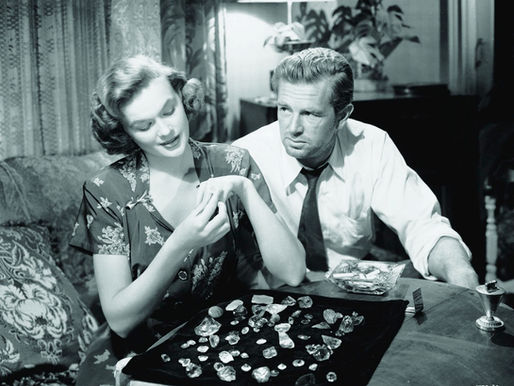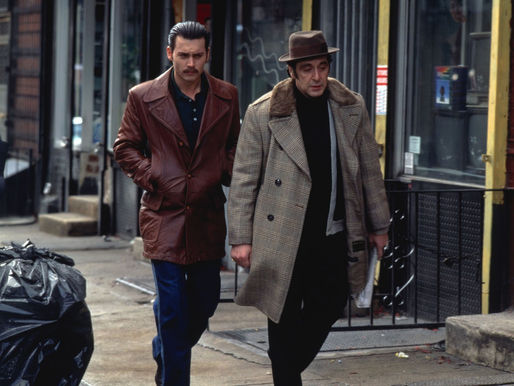top of page
Search
Crime / Mystery
Classic Crime / Mystery Films from 1930 - 1999


Home Alone (1990)
When Home Alone premiered in 1990, few could have predicted that this modestly budgeted family comedy would become one of the most successful Christmas films of all time. Directed by Chris Columbus and written by John Hughes—two of the most influential figures in late 20th-century American family cinema—the film quickly evolved from a seasonal hit into a cultural phenomenon.

Soames Inscker
4 min read


The Nightmare Before Christmas (1993)
Tim Burton’s The Nightmare Before Christmas—directed by Henry Selick though often popularly associated with Burton himself—is a remarkable fusion of gothic fantasy, festive charm, and innovative stop-motion animation. Since its release in 1993, it has grown from a modestly received curiosity into a beloved classic, celebrated for its originality, artistry, and ability to enchant audiences of all ages.

Soames Inscker
3 min read


Birdman of Alcatraz (1962)
Released in 1962, Birdman of Alcatraz remains one of the most thoughtful and humane prison dramas in American cinema. Directed by John Frankenheimer and anchored by a towering performance from Burt Lancaster, the film transcends its genre to explore profound questions of redemption, isolation, and the indomitable human spirit.

Soames Inscker
6 min read


The Quatermass Experiment (1955)
When The Quatermass Experiment was released in 1955, British science fiction was still a relatively unexplored genre in cinema. While America had already embraced flying saucers, atomic monsters, and Cold War paranoia, the United Kingdom’s screen science fiction had been more restrained and intellectual.

Soames Inscker
4 min read


The First Great Train Robbery (1978)
Michael Crichton’s The First Great Train Robbery (released simply as The Great Train Robbery in some territories) is a delightfully crafted caper film that blends historical authenticity, dry wit, and old-fashioned adventure. Based on Crichton’s own 1975 novel, itself inspired by the true events of the 1855 Great Gold Robbery, the film captures the ingenuity and daring spirit of the Victorian age with panache.

Soames Inscker
3 min read


The Naked Gun: From the Files of Police Squad! (1988)
Few comedies of the 1980s have retained their impact and sheer hilarity quite like The Naked Gun: From the Files of Police Squad! — a film that not only revitalised the spoof genre but also cemented Leslie Nielsen’s status as one of cinema’s most beloved comic actors. Directed by David Zucker and co-written by Jerry Zucker, Jim Abrahams, and Pat Proft, The Naked Gun is a masterclass in absurdist humour — a film that gleefully dismantles the conventions of the police procedura

Soames Inscker
4 min read


Eyes Wide Shut (1999)
Directed by the legendary Stanley Kubrick, Eyes Wide Shut was released in 1999, just months after the director’s death, and stands as one of the most enigmatic and provocative works of his career. Starring Tom Cruise and Nicole Kidman, the film is a haunting exploration of desire, jealousy, and the fragile boundaries between reality and fantasy. Adapted from Arthur Schnitzler’s 1926 novella Traumnovelle (Dream Story), Kubrick relocates the story from fin-de-siècle Vienna to m

Soames Inscker
5 min read


Straight Time (1978)
Released in 1978, Straight Time is a gritty, uncompromising crime drama directed by Ulu Grosbard (with uncredited early direction by Dustin Hoffman). Adapted from Edward Bunker’s semi-autobiographical novel No Beast So Fierce, the film presents a harrowing portrait of recidivism, alienation, and the crushing weight of a society unwilling to forgive.

Soames Inscker
4 min read


The Asphalt Jungle (1950)
John Huston’s The Asphalt Jungle (1950) is a seminal entry in the canon of American film noir, a taut crime thriller that helped redefine the heist genre. Adapted from W. R. Burnett’s novel, the film moves away from the glamour and sensationalism of earlier Hollywood crime pictures, presenting instead a sober, almost documentary-like account of criminal enterprise.

Soames Inscker
4 min read


Donnie Brasco (1997)
Mike Newell’s Donnie Brasco is a gripping 1997 crime drama that delves deep into the psychological and emotional toll of undercover work in the mafia. Based on true events and Joseph D. Pistone’s memoir Donnie Brasco: My Undercover Life in the Mafia, the film presents a nuanced portrait of loyalty, deception, and the blurry moral lines that define the world of organized crime.

Soames Inscker
4 min read


Batman Forever (1995)
Batman Forever, directed by Joel Schumacher and released in 1995, marked a dramatic tonal shift in the Batman film franchise. Following the darker, gothic stylings of Tim Burton’s “Batman” (1989) and “Batman Returns” (1992), Schumacher’s installment introduced a more vibrant, comic-book-inspired aesthetic.

Soames Inscker
4 min read


Basic Instinct (1992)
Basic Instinct, directed by Paul Verhoeven and released in 1992, is one of the most provocative and controversial films of the 1990s — a neo-noir erotic thriller that shocked audiences with its explicit sexuality, ambiguous morality, and psychological complexity.

Soames Inscker
4 min read


The Godfather Part III (1990)
The Godfather Part III, released in 1990, is one of cinema’s most debated conclusions to a beloved saga. Serving as the epilogue to Francis Ford Coppola’s monumental crime saga, this third entry attempts to tie a definitive bow on the saga of Michael Corleone—a man who sought legitimacy but never escaped the sins of his past.

Soames Inscker
3 min read


Carlito's Way (1993)
Brian De Palma’s Carlito’s Way (1993) is a stylish, operatic crime drama that blends the director’s signature flair for cinematic bravado with a surprisingly soulful story of redemption. With a powerhouse performance by Al Pacino and a sharp supporting turn from Sean Penn, the film stands as one of the most underrated entries in the gangster genre—a meditation on past sins, impossible dreams, and the gravitational pull of the streets.

Soames Inscker
3 min read


Dead Again (1991)
Kenneth Branagh's Dead Again is a stylish, twist-laden neo-noir thriller that doubles as a Gothic romance, drawing on classic Hollywood influences while showcasing Branagh’s flair for ambitious storytelling. Combining reincarnation, murder, mistaken identity, and fate, the film straddles genres and eras, delivering a visually arresting and emotionally satisfying mystery that feels both old-fashioned and fresh.

Soames Inscker
4 min read


The Talented Mr Ripley (1999)
Elegant, haunting, and psychologically complex, The Talented Mr. Ripley (1999) is a chilling exploration of identity, obsession, and moral ambiguity. Directed by Anthony Minghella and adapted from Patricia Highsmith’s 1955 novel, the film is both a sun-drenched European travelogue and a deeply unsettling psychological thriller.

Soames Inscker
4 min read


In the Name of the Father (1993)
In the Name of the Father is a powerful, emotionally charged courtroom drama and political thriller that dramatises the real-life miscarriage of justice involving the “Guildford Four.” Released in 1993 and directed by Jim Sheridan (My Left Foot, The Field), the film stars Daniel Day-Lewis in one of his most impassioned performances as Gerry Conlon, a man wrongly imprisoned for an IRA bombing he did not commit.

Soames Inscker
4 min read


Casino (1995)
Released in 1995, Casino marks another towering achievement in the crime genre by director Martin Scorsese. Based on the non-fiction book Casino: Love and Honour in Las Vegas by Nicholas Pileggi (who co-wrote the screenplay with Scorsese), the film offers a blistering, operatic chronicle of greed, ambition, betrayal, and the slow decay of organised crime’s influence in Las Vegas.

Soames Inscker
4 min read


L.A. Confidential (1997)
Curtis Hanson’s L.A. Confidential is a masterwork of modern noir—an intricate, atmospheric, and unflinchingly sharp crime drama that revives and redefines the genre. Based on James Ellroy’s dense 1990 novel, the film adapts its labyrinthine plot and dark themes into a compelling and accessible cinematic experience.

Soames Inscker
3 min read


Leon (1994)
When Léon: The Professional premiered in 1994, it didn’t just introduce audiences to one of Luc Besson’s most stylish and emotionally complex films—it also launched a career (Natalie Portman), redefined another (Jean Reno), and gave Gary Oldman one of his most disturbingly magnetic roles. Over the years, it has become a cult classic, both celebrated for its raw emotional power and criticized for its unsettling implications.

Soames Inscker
4 min read
bottom of page


